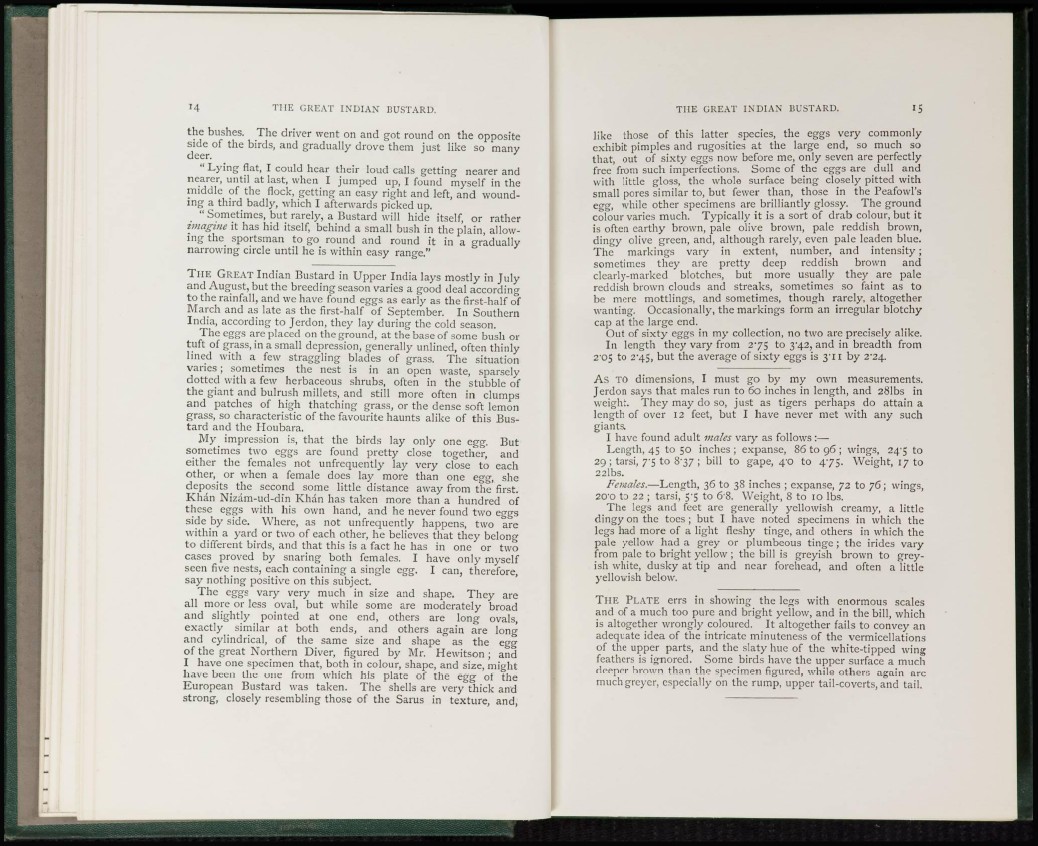
the bushes. The driver went on and got round on the opposite
side of the birds, and gradually drove them just like so many
deer.
" Lying flat, I could hear their loud calls getting nearer and
nearer, until at last, when I jumped up, I found myself in the
middle of the flock, getting an easy right and left, and wounding
a third badly, which I afterwards picked up.
" Sometimes, but rarely, a Bustard will hide itself, or rather
imagine it has hid itself, behind a small bush in the plain, allowing
the sportsman to go round and round it in a gradually
narrowing circle until he is within easy range."
T H E GREAT Indian Bustard in Upper India lays mostly in July
and August, but the breeding season varies a good deal according
to the rainfall, and we have found eggs as early as the first-half of
March and as late as the first-half of September. In Southern
India, according to Jerdon, they lay during the cold season.
The eggs arc placed on the ground, at the base of some bush or
tuft of grass, in a small depression, generally unlined, often thinly
lined with a few straggling blades of grass. The situation
varies; sometimes the nest is in an open waste, sparsely
dotted with a few herbaceous shrubs, often in the stubble of
the giant and bulrush millets, and still more often in clumps
and patches of high thatching grass, or the dense soft lemon
grass, so characteristic of the favourite haunts alike of this Bustard
and the Houbara.
My impression is, that the birds lay only one egg. But
sometimes two eggs are found pretty close together, and
either the females not unfrcquently lay very close to each
other, or when a female does lay more than one egg, she
deposits the second some little distance away from the first.
Khan Nizam-ud-din Khan has taken more than a hundred of
these eggs with his own hand, and he never found two eggs
side by side. Where, as not unfrcquently happens, two are
within a yard or two of each other, he believes that they belong
to different birds, and that this is a fact he has in one or two
cases proved by snaring both females. I have only myself
seen five nests, each containing a single egg. I can, therefore,
say nothing positive on this subject.
The eggs vary very much in size and shape. They are
all more or less oval, but while some are moderately broad
and slightly pointed at one end, others are long ovals,
exactly similar at both ends, and others again are long
and cylindrical, of the same size and shape as the egg
of the great Northern Diver, figured by Mr. Hewitson ; and
I have one specimen that, both in colour, shape, and size, might
have been the one from which his plate of the egg of the
European Bustard was taken. The shells are very thick and
strong, closely resembling those of the Sarus in texture, and,
like those of this latter species, the eggs very commonly
exhibit pimples and rugosities at the large end, so much so
that, out of sixty eggs now before me, only seven are perfectly
free from such imperfections. Some of the eggs are dull and
with little gloss, the whole surface being closely pitted with
small pores similar to, but fewer than, those in the Peafowl's
egg, while other specimens are brilliantly glossy. The ground
colour varies much. Typically it is a sort of drab colour, but it
is often earthy brown, pale olive brown, pale reddish brown,
dingy olive green, and, although rarely, even pale leaden blue.
The markings vary in extent, number, and intensity;
sometimes they are pretty deep reddish brown and
clearly-marked blotches, but more usually they are pale
reddish brown clouds and streaks, sometimes so faint as to
be mere mottlings, and sometimes, though rarely, altogether
wanting. Occasionally, the markings form an irregular blotchy
cap at the large end.
Out of sixty eggs in my collection, no two are precisely alike.
In length they vary from 275 to 3^42, and in breadth from
2'05 to 2'45, but the average of sixty eggs is 3 1 1 by 2'24.
As T O dimensions, I must go by my own measurements.
Jerdon says that males run to 60 inches in length, and 281bs in
weight. They may do so, just as tigers perhaps do attain a
length of over 12 feet, but I have never met with any such
giants.
I have found adult males vary as follows:—
Length, 45 to 50 inches ; expanse, 86 to 96 ; wings, 24^5 to
29 ; tarsi, ys to 8-37 ; bill to gape, 4-0 to 475. Weight, 17 to
22lbs.
Females.—Length, 36 to 38 inches ; expanse, 72 to 76; wings,
20'0 to 22 ; tarsi, 5-5 to 6'8. Weight, 8 to 10 lbs.
The legs and feet are generally yellowish creamy, a little
dingy on the toes; but I have noted specimens in which the
legs had more of a light fleshy tinge, and others in which the
pale yellow had a grey or plumbeous tinge; the irides vary
from pale to bright yellow ; the bill is greyish brown to greyish
white, dusky at tip and near forehead, and often a little
yellowish below.
THE PLATE errs in showing the legs with enormous scales
and of a much too pure and bright yellow, and in the bill, which
is altogether wrongly coloured. It altogether fails to convey an
adequate idea of the intricate minuteness of the vermicellations
of the upper parts, and the slaty hue of the white-tipped wing
feathers is ignored. Some birds have the upper surface a much
deeper brown than the specimen figured, while others again are
much greyer, especially on the rump, upper tail-coverts, and tail.